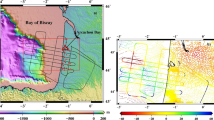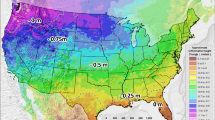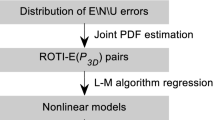Abstract
The ionospheric F2-layer peak density (NmF2) and its height (hmF2) are of great influence on the shape of the ionospheric electron density profile Ne (h) and may be indicative of other physical processes within the ionosphere, especially those due to geomagnetic storms. Such parameters are often estimated using models such as the semiempirical international reference ionosphere (IRI) models or are measured using moderately priced to expensive instrumentation, such as ionosondes or incoherent scatter radars. Global positioning system (GPS) observations have become a powerful tool for mapping high-resolution ionospheric structures, which can be used to study the ionospheric response to geomagnetic storms. In this paper, we describe how 3-D ionospheric electron density profiles were produced from data of the dense permanent Korean GPS network using the tomography reconstruction technique. These profiles are verified by independent ionosonde data. The responses of GPS-derived parameters at the ionospheric F2-layer to the 20th November 2003 geomagnetic storm over South Korea are investigated. A fairly large increase in the electron density at the F2-layer peak (the NmF2) (positive storm) has been observed during this storm, which is accompanied by a significant uplift in the height of the F2 layer peak (the hmF2). This is confirmed by independent ionosonde observations. We suggest that the F2-layer peak height uplift and NmF2 increase are mainly associated with a strong eastward electric field, and are not associated with the increase of the O/N2 ratio obtained from the GUVI instruments aboard the TIMED satellite. It is also inferred that the increase in NmF2 is not caused by the changes in neutral composition, but is related to other nonchemical effects, such as dynamical changes of vertical ion motions induced by winds and E × B drifts, tides and waves in the mesosphere/lower thermosphere region, which can be dynamically coupled upward to generate ionospheric perturbations and oscillations.
Similar content being viewed by others

References
Austen JR, Franke SG and Liu CH (1988). Ionospheric imaging using computerized tomography. Radio Sci 23: 299–307
Afraimovich E, Kosogorov EA and Leonovich LA (2000). Determining parameters of large scale traveling ionospheric disturbances of auroral origin using GPS arrays. J Atmos Sol Terr Phy 62: 553–565
Bhuyan PK, Lakha S and Tyagi TR (1986). Equivalent slab thickness of the ionosphere over 26°N through the ascending half of a solar cycle. Ann Geophys 4: 131–136
Buonsanto MJ and Foster JC (1993). Effects of magnetospheric electric fields and neutral winds on the low-middle latitude ionosphere during the March 20–21, 1990, storm. J Geophys Res 98: 19133–19140
Christensen AB, Paxton LJ, Avery S, et al (2003) Initial observations with the Global Ultraviolet Imager (GUVI) in the NASATIMED satellite mission. J Geophys Res 108(A12):1451. doi:10.1029/2003JA009918
Davies K, Fritz RB and Gray TB (1976). Measurement of columnar electron contents of the ionosphere and plasmasphere. J Geophys Res 81: 2825–2834
Davies K, Liu XM (1991) Ionospheric slab thickness in middle and low-latitudes. Radio Sci 26:997–1005
Davis CJ, Wild MN, Lockwood M and Tulunay YK (1997). Ionospheric and geomagnetic responses to changes in IMF Bz: a superposed epoch study. Ann Geophys 15: 217–230
Dungey JW (1961). Interplanetary magnetic field and the auroral zones. Phys Rev Lett 6: 47–48
Forbes JM, Roble RG and Fesen CG (1993). Acceleration, heating, and compositional mixing of the thermosphere due to upward propagating tides. J Geophys Res 98: 311–321
Foster J (1993). Storm time plasma transport at middle and high latitudes. J Geophys Res 98(A2): 1675–1689
Foster J, Erickson P, Coster A, Goldstein J, Rich F (2002) Ionospheric signatures of plasmaspheric tails. Geophys Res Lett 29(13):1623. doi:10.1029/2002GL015067
Foster J and Vo H (2002). Average characteristics and activity dependence of the subauroral polarization stream. J Geophys Res 107(A12): 1475
Foster J, Coster A, Erickson P, Rich F, Sandel B (2004) Stormtime observations of the flux of plasmaspheric ions to the dayside cusp/magnetopause, Geophys Res Lett 31:L08809. doi:10.1029/2004GL020082
Fuller-Rowell TJ, Codrescu MV, Moffett RJ and Quegan S (1994). Response of the thermosphere and ionosphere to geomagnetic storms. J Geophys Res 99: 3893–3914
Fuller-Rowell TJ, Codrescu MV, Rishbeth H, Moffet RJ and Quegan S (1996). On the seasonal response of the thermosphere and ionosphere to geomagnetic storms. J Geophys Res 101(A2): 2343–2353
Gao Y and Liu ZZ (2002). Precise ionosphere modelling using regional GPS network data. J Glob Position Syst 1: 18–24
Goncharenko LP, Foster J, Coster A, Huang C, Aponte N and Paxton L (2007). Observations of a positive storm phase on September 10, 2005. J Atmos Solar Terr Phys 69: 1253–1272
Gordon R, Bender R and Therman G (1970). Algebraic reconstruction Techniques (ART) for three dimensional electron micoscopy and X-ray photography. J Theor Biol 29: 471–481
Huang C, Foster J, Kelley M (2005a) Long duration penetration of the interplentary electric field to the lowlatitude ionosphere during the main phase of magnetic storms. J Geophys Res 110:A11309. doi:10.1029/2005JA011202
Huang C, Foster J, Goncharenko J, Erickson P, Rideout W (2005b) A strong positive phase of ionospheric storms observed by the Millstone Hill incoherent scatter radar and global GPS network. J Geophys Res 110:A06303. doi:10.1029/2004JA010865
Jin SG, Wang JL, Zhang HP and Zhu WY (2004). Real-time monitoring and prediction of the total ionospheric electron content (TEC) by means of GPS. Chin Astron Astrophys 28(3): 331–337
Jin SG and Park PH (2006). Strain accumulation in South Korea inferred from GPS measurements. Earth Planets Space 58(5): 529–534
Jin SG, Park J, Wang J and Choi B (2006). Electron density profiles derived from ground-based GPS observations. J Navig 59(3): 395– 401
Jin SG, Park J and Park PH (2007). GPS ionospheric tomography: a comparison with the IRI-2001 model over South Korea. Earth Planets Space 59(4): 287–292
Kersley L and Hosseinieh HH (1976). Dependence of ionospheric slab thickness on geomagnetic activity. J Atmos Terr Phys 38: 1357–1360
Lei J, Liu L, Wan W and Zhang S (2004). Modeling the behavior of ionosphere above Millstone Hill during the September 21–27, 1998 storm. J Atmos Solar Terr Phys 66: 1093–1102
Mannucci A, Tsurutani B, Iijima B, Komjathy A, Saito A, Gonzales W, Guarnieri F, Kozyra J, Skoug R (2005) Dayside global ionospheric response to the major interplanetary events of October 29–30, 2003 “Halloween Storms”. Geophys Res Lett 32:L12S02. doi:10.1029/2004GL021467
Mendillo M, Rishbeth H, Roble RG and Wroten J (2002). Modelling F2-layer seasonal trends and day-to-day variability driven by coupling with the lower atmosphere. J Atmos Solar Terr Phys 64: 1911–1931
Raymund TD, Austen JR and Franke SJ (1990). Application of computerized tomography to the investigation of ionospheric structures. Radio Sci 25: 771–789
Ruffini G, Flores A and Rius A (1998). GPS tomography of the ionospheric electron content with a correlation functional. IEEE Trans Geosci Remote Sens 36(1): 143–153
Sardon E, Rius A and Zarraoa N (1994). Estimation of the transmitter and receiver differential biases and the ionospheric total electron content from global positioning system observations. Radio Sci 29(3): 577–586
Strickland DJ, Evans JS and Paxton LJ (1995). Satellite remote sensing of thermospheric O/N2 and solar EUV. 1. Theory. J Geophys Res 100(A7): 12217–12226
Strickland DJ, Meier RR, Walterscheid RL, Craven JD, Christensen AB, Paxton LJ, Morrison D, Crowley G (2004) Quiet time seasonal behaviour of the thermosphere seen in the far ultraviolet dayglow. J Geophys Res 109:A01302. doi:10.1029/2003JA010220
Swisdak M, Huba J, Joyce GC, Huang C (2006) Simulation study of a positive ionospheric storm phase observed at Millstone Hill. Geophys Res Lett 33:L02104. doi:10.1029/2005GL024973
Szuszczewicz EP, Lester M, Wilkinson P, Blanchard P, Abdu M, Hanbaba R, Igarashi K, Pulinets S and Reddy BM (1998). A comparative study of global ionospheric responses to intense magnetic storm conditions. J Geophys Res 103(A6): 11665–11684
Tsai LC, Liu CH, Tsai WH and Liu CT (2002). Tomographic imaging of the ionosphere using the GPS/MET and NNSS data. J Atmos Solar Terr Phys 64: 2003–2011
Tsurutani B, Mannucci A, Iijima B, Ali Abdu M, Sobral J, Gonzalez W, Guarnieri F, Tsuda T, Saito A, Yumoto K, Fejer B, Fuller- Rowell T, Kozyra J, Foster J, Coster A, Vasyliunas V (2004) Global dayside ionospheric uplift and enhancement associated with interplanetary electric fields. J Geophys Res 109:A08302. doi:10.1029/2003JA010342
Wall ME, Dyck PA and Brettin TS (2001). SVDMAN—singular value decomposition analysis of microarray data. Bioinformatics 17: 566–568
Yamamoto A, Ohta Y, Okuzawa T, Taguchi S, Tomizawa I and Shibata T (2000). Characteristics of TEC variations observed at Chofu for geomagnetic storms. Earth Planets Space 52: 1073–1076
Yin P, Mitchell CN, Spencer PS, Foster JC (2004) Ionospheric electron concentration imaging using GPS over the USA during the storm of July 2000. Geophys Res Lett 31:L12806. doi:10.1029/2004GL019899
Author information
Authors and Affiliations
Corresponding author
Rights and permissions
About this article
Cite this article
Jin, S., Luo, O.F. & Park, P. GPS observations of the ionospheric F2-layer behavior during the 20th November 2003 geomagnetic storm over South Korea. J Geod 82, 883–892 (2008). https://doi.org/10.1007/s00190-008-0217-x
Received:
Accepted:
Published:
Issue Date:
DOI: https://doi.org/10.1007/s00190-008-0217-x



